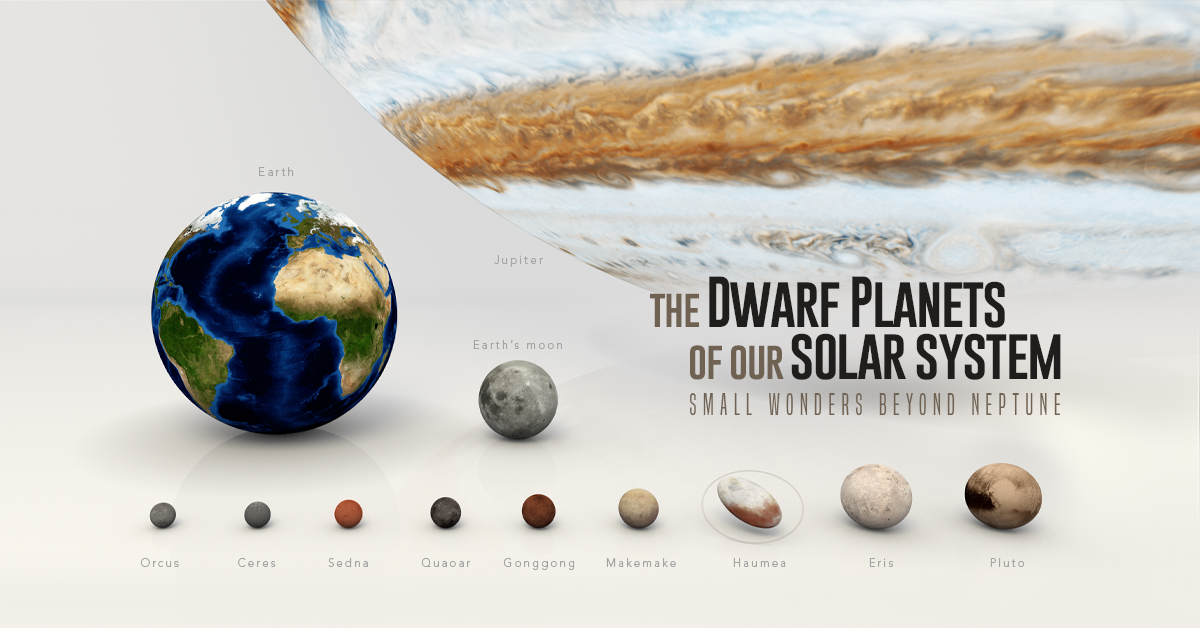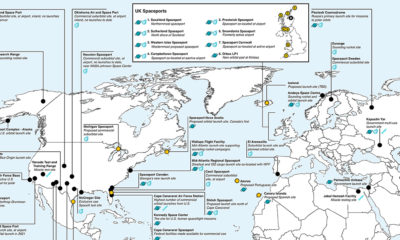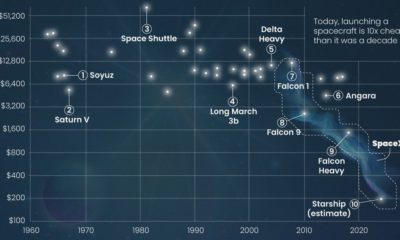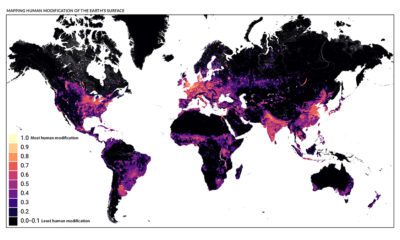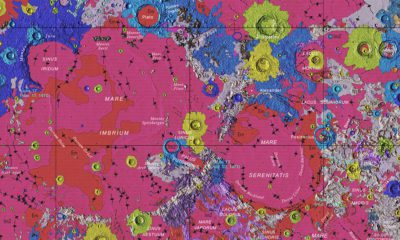Misc
A Visual Introduction to the Dwarf Planets in our Solar System
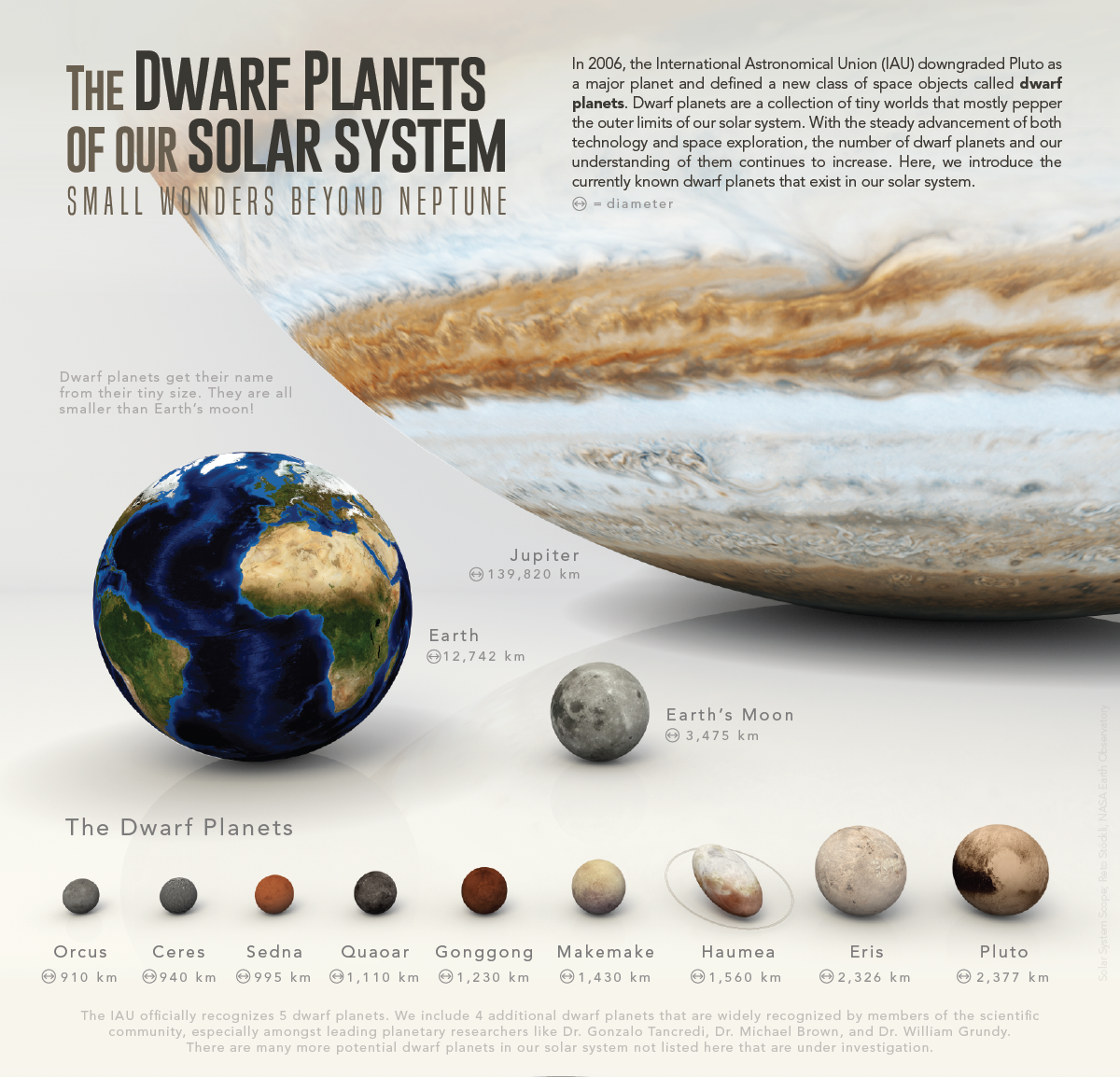
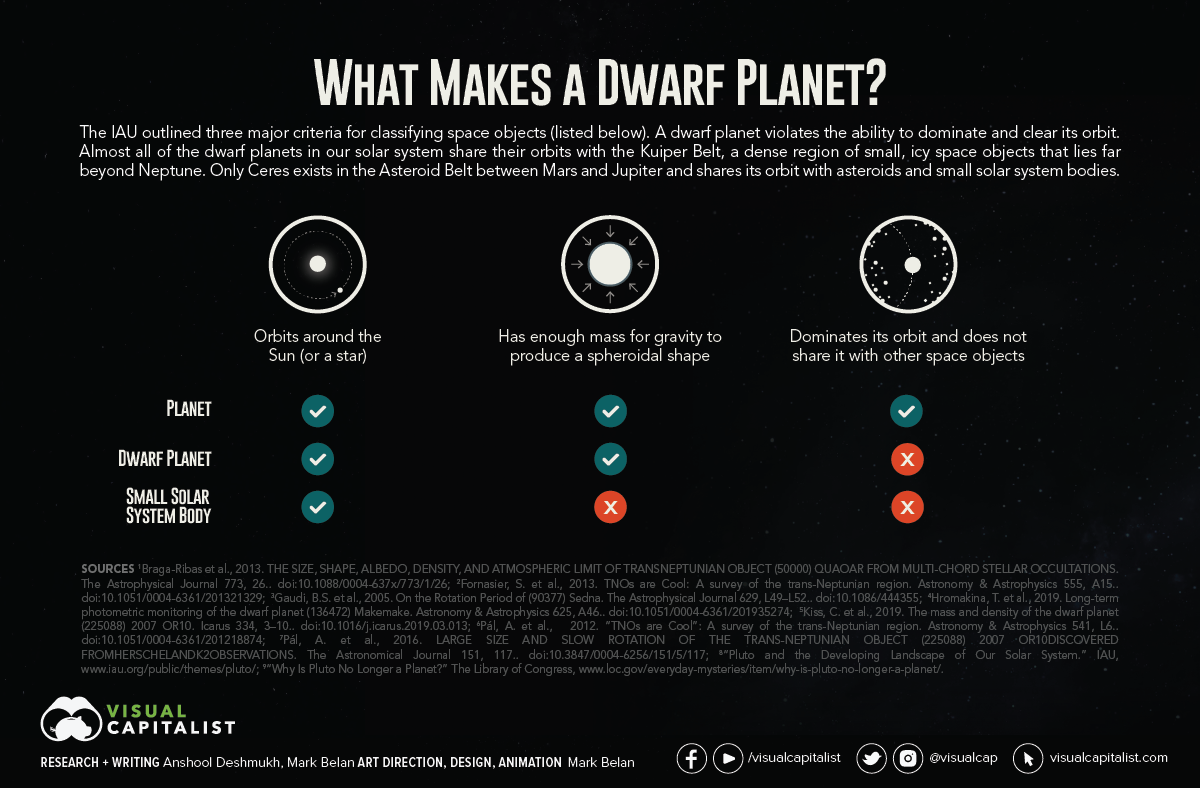
Pluto and the Introduction of Dwarf Planets
Since its discovery in 1930, Pluto has been a bit of a puzzle.
For starters, not only is Pluto smaller than any other planet in the solar system, but it’s also smaller than Earth’s moon. It also has an extremely low gravitational pull at only 0.07 times the mass of the objects in its orbit, which is just a fraction of the Moon’s own strength.
At the same time, Pluto’s surface resembles that of terrestrial planets such as Mars, Venus or the Earth, yet its nearest neighbors are the gaseous Jovian planets such as Uranus or Neptune. In fact, Pluto’s orbit is so erratic that it led many scientists to initially believe that it originated elsewhere in space and the Sun’s gravity pulled it in.
These qualities have challenged the scientific view of Pluto’s status as a planet for years. It wasn’t until the discovery of Eris in 2005, one of many increasingly identified trans-Neptunian objects (objects beyond the planet Neptune), that the International Astronomical Union (IAU) defined criteria for classifying planets.
With Eris and other trans-Neptunian objects sharing similar characteristics with Pluto, the definition for dwarf planets was created, and Pluto got downgraded in 2006.
So what are dwarf planets, how do they differ from “true” planets and what are their characteristics?
The History of Dwarf Planets
A dwarf planet is a celestial body that almost meets the definition of a “true” planet. According to the IAU, which sets definitions for planetary science, a planet must:
- Orbit the Sun.
- Have enough mass to achieve hydrostatic equilibrium and assume a nearly round shape.
- Dominate its orbit and not share it with other objects.
Dwarf planets, along with not being moons or satellites, fail to clear the neighborhoods around their orbits. This is the primary reason why Pluto lost its status: because it shares part of its orbit with the Kuiper belt, a dense region of icy space bodies.
Based on this definition, the IAU has recognized five dwarf planets: Pluto, Eris, Makemake, Haumea, and Ceres. There are four more planetary objects*, namely Orcus, Sedna, Gonggong and Quaoar, that the majority of the scientific community recognize as dwarf planets.
Six more could be recognized in the coming years, and as many as 200 or more are hypothesized to exist in the Outer Solar System in the aforementioned Kuiper belt.
Ceres is the earliest known and smallest of the current category of dwarf planets. Previously classified as an asteroid in 1801, it was confirmed to be a dwarf planet in 2006. Ceres lies between Mars and Jupiter in the asteroid belt, and it is the only dwarf planet that orbits closest to Earth.
Here is a brief introduction to the most recognized dwarf planets:
| Name | Region of the Solar System | Orbital period (in years) | Mean orbital speed (km/s) | Diameter (km) | Diameter relative to the Moon | Moons |
|---|---|---|---|---|---|---|
| Orcus | Kuiper belt (plutino) | 247 | 4.75 | 910 | 26% | 1 |
| Ceres | Asteroid belt | 4.6 | 17.9 | 940 | 27% | 0 |
| Pluto | Kuiper belt (plutino) | 248 | 4.74 | 2377 | 68% | 5 |
| Haumea | Kuiper belt (12:7) | 285 | 4.53 | 1560 | ≈ 45% | 2 |
| Quaoar | Kuiper belt (cubewano) | 289 | 4.51 | 1110 | 32% | 1 |
| Makemake | Kuiper belt (cubewano) | 306 | 4.41 | 1430 | 41% | 1 |
| Gonggong | Scattered disc (10:3) | 554 | 3.63 | 1230 | 35% | 1 |
| Eris | Scattered disc | 558 | 3.62 | 2326 | 67% | 1 |
| Sedna | Detached | ~11,400 | ~1.3 | 995 | 29% | N/A |
Interesting Facts about Dwarf Planets
Here are a few interesting facts about the dwarf planets discovered in our solar system:
Ceres loses 6kg of its mass in steam every second
The Herschel Space Telescope observed plumes of water vapor shooting up from Ceres’ surface; this was the first definitive observation of water vapor in the asteroid belt. This happens when portions of Ceres’ icy surface warm up and turn into steam.
A day on Haumea lasts 3.9 hours
Haumea has a unique appearance due to its rotation, which is so rapid that it compresses the planet into an egg-like shape. Its rotational speed and collisional origin also make Haumea one of the densest dwarf planets discovered to date.
Makemake was named three years after its discovery in 2005
Makemake’s discovery close to Easter influenced both its name and nickname. Before being named after the creator of humanity and god of fertility in the mythos of the Rapa Nui (the native people of Easter Island), Makemake was nicknamed “Easter bunny” by its discoverer Mike Brown.
Eris was once considered for the position of the 10th planet
Eris is the most massive dwarf planet in the solar system, exceeding Pluto’s mass by 28%. As such, it was a serious contender to become the tenth planet but failed to meet the criteria set out by the IAU.
Pluto is one-third ice
The planet’s composition makes up two-thirds rock and one-third ice, mostly a mixture of methane and carbon dioxide. One day on Pluto is 153.6 hours, approximately 6.4 Earth days, making it one of the slowest rotating dwarf planets.
Exploratory Missions and New Planets on the Horizon
With newer technology rapidly available to the scientific community and new exploratory missions getting more data and information about trans-Neptunian objects, our understanding of dwarf planets will increase.
Nestled in the asteroid belt between Mars and Jupiter, the asteroid Hygiea remains a controversy. Hygiea is the fourth largest object in the asteroid belt behind Ceres, Vesta, and Pallas and ticks all the boxes necessary to be classified as a dwarf planet.
So what’s holding back Hygiea’s confirmation as a dwarf planet? The criterion for being massive enough to form a spherical shape is in contention; it remains unclear if its roundness results from collision/impact disruption or its mass/gravity.
Along with Hygiea, other exciting dwarf planets could be soon discovered. Here is a quick rundown of some serious contenders:
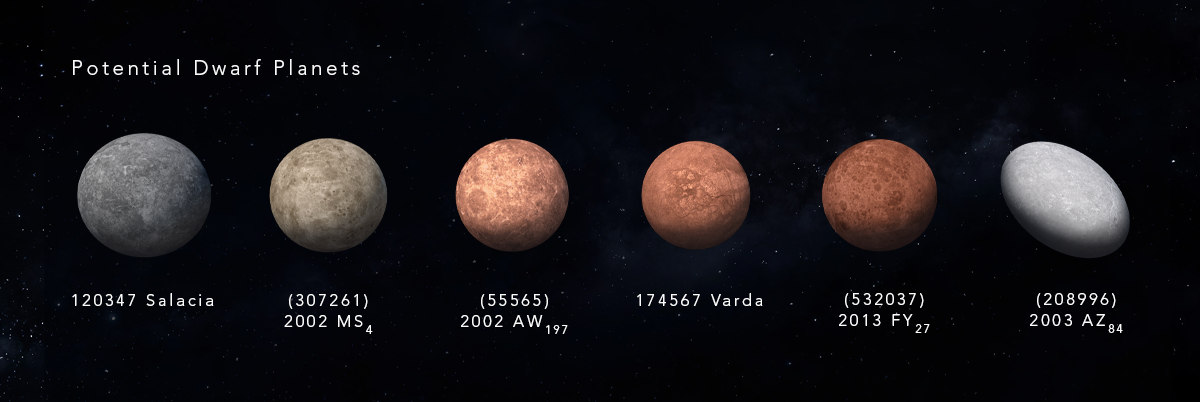
120347 Salacia
Discovered in 2004, it is a trans-Neptunian object in the Kuiper belt, approximately 850 kilometers in diameter. As of 2018, it is located about 44.8 astronomical units from the Sun. Salacia’s status is in contention because its planetary density is arguable. It is uncertain if it can exist in hydrostatic equilibrium.
(307261) 2002 MS4
With an estimated diameter of 934±47 kilometers, 2002 MS4 is comparable in size to Ceres. Researchers need more data to determine whether 2002 MS4 is a dwarf planet or not.
(55565) 2002 AW197
Discovered at the Palomar Observatory in 2002, it has a rotation period of 8.8 hours, a moderately red color (similar to Quaoar) and no apparent planetary geology. Its low albedo has made it difficult to determine whether or not it is a dwarf planet.
174567 Varda
Varda takes its name after the queen of the Valar, creator of the stars, one of the most powerful servants of almighty Eru Iluvatar in J. R. R. Tolkien’s fictional mythology. Varda’s status as a dwarf planet is uncertain because its size and albedo suggest it might not be a fully solid body.
(532037) 2013 FY27
This space object has a surface diameter of about 740 kilometers. It orbits the Sun once every 449 years. Researchers need more data on the planet’s mass and density to determine if it is a dwarf planet or not.
(208996) 2003 AZ84
It is approximately 940 kilometers across its longest axis, as it has an elongated shape. This shape is presumably due to its rapid rotation rate of 6.71 hours, similar to that of other dwarf planets like Haumea. Like Varda, it remains unknown if this object has compressed into a fully solid body and thus remains contentious amongst astronomers regarding its planetary status.
*Note: The IAU officially recognizes five dwarf planets. We include four additional dwarf planets widely acknowledged by members of the scientific community, especially amongst leading planetary researchers like Gonzalo Tancredi, Michael Brown, and William Grundy. There are many more potential dwarf planets not listed here that remain under investigation.
Maps
The Largest Earthquakes in the New York Area (1970-2024)
The earthquake that shook buildings across New York in April 2024 was the third-largest quake in the Northeast U.S. over the past 50 years.

The Largest Earthquakes in the New York Area
This was originally posted on our Voronoi app. Download the app for free on Apple or Android and discover incredible data-driven charts from a variety of trusted sources.
The 4.8 magnitude earthquake that shook buildings across New York on Friday, April 5th, 2024 was the third-largest quake in the U.S. Northeast area over the past 50 years.
In this map, we illustrate earthquakes with a magnitude of 4.0 or greater recorded in the Northeastern U.S. since 1970, according to the United States Geological Survey (USGS).
Shallow Quakes and Older Buildings
The earthquake that struck the U.S. Northeast in April 2024 was felt by millions of people from Washington, D.C., to north of Boston. It even caused a full ground stop at Newark Airport.
The quake, occurring just 5 km beneath the Earth’s surface, was considered shallow, which is what contributed to more intense shaking at the surface.
According to the USGS, rocks in the eastern U.S. are significantly older, denser, and harder than those on the western side, compressed by time. This makes them more efficient conduits for seismic energy. Additionally, buildings in the Northeast tend to be older and may not adhere to the latest earthquake codes.
Despite disrupting work and school life, the earthquake was considered minor, according to the Michigan Technological University magnitude scale:
| Magnitude | Earthquake Effects | Estimated Number Each Year |
|---|---|---|
| 2.5 or less | Usually not felt, but can be recorded by seismograph. | Millions |
| 2.5 to 5.4 | Often felt, but only causes minor damage. | 500,000 |
| 5.5 to 6.0 | Slight damage to buildings and other structures. | 350 |
| 6.1 to 6.9 | May cause a lot of damage in very populated areas. | 100 |
| 7.0 to 7.9 | Major earthquake. Serious damage. | 10-15 |
| 8.0 or greater | Great earthquake. Can totally destroy communities near the epicenter. | One every year or two |
The largest earthquake felt in the area over the past 50 years was a 5.3 magnitude quake that occurred in Au Sable Forks, New York, in 2002. It damaged houses and cracked roads in a remote corner of the Adirondack Mountains, but caused no injuries.
| Date | Magnitude | Location | State |
|---|---|---|---|
| April 20, 2002 | 5.3 | Au Sable Forks | New York |
| October 7, 1983 | 5.1 | Newcomb | New York |
| April 5, 2024 | 4.8 | Whitehouse Station | New Jersey |
| October 16, 2012 | 4.7 | Hollis Center | Maine |
| January 16, 1994 | 4.6 | Sinking Spring | Pennsylvania |
| January 19, 1982 | 4.5 | Sanbornton | New Hampshire |
| September 25, 1998 | 4.5 | Adamsville | Pennsylvania |
| June 9, 1975 | 4.2 | Altona | New York |
| May 29, 1983 | 4.2 | Peru | Maine |
| April 23, 1984 | 4.2 | Conestoga | Pennsylvania |
| January 16, 1994 | 4.2 | Sinking Spring | Pennsylvania |
| November 3, 1975 | 4 | Long Lake | New York |
| June 17, 1991 | 4 | Worcester | New York |
The largest earthquake in U.S. history, however, was the 1964 Good Friday quake in Alaska, measuring 9.2 magnitude and killing 131 people.
-

 Business2 weeks ago
Business2 weeks agoAmerica’s Top Companies by Revenue (1994 vs. 2023)
-

 Environment1 week ago
Environment1 week agoRanked: Top Countries by Total Forest Loss Since 2001
-

 Markets1 week ago
Markets1 week agoVisualizing America’s Shortage of Affordable Homes
-

 Maps2 weeks ago
Maps2 weeks agoMapped: Average Wages Across Europe
-

 Mining2 weeks ago
Mining2 weeks agoCharted: The Value Gap Between the Gold Price and Gold Miners
-

 Demographics2 weeks ago
Demographics2 weeks agoVisualizing the Size of the Global Senior Population
-

 Misc2 weeks ago
Misc2 weeks agoTesla Is Once Again the World’s Best-Selling EV Company
-

 Technology2 weeks ago
Technology2 weeks agoRanked: The Most Popular Smartphone Brands in the U.S.




